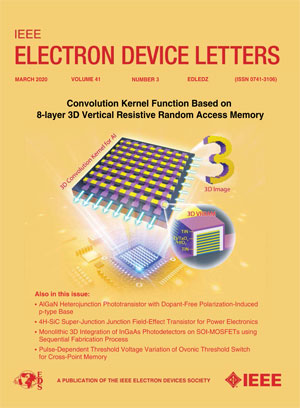Synergistic Carbonyl and Cyano Passivation for Efficient Blade-Coated Perovskite Solar Cells
IF 4.1
2区 工程技术
Q2 ENGINEERING, ELECTRICAL & ELECTRONIC
引用次数: 0
Abstract
Homogeneous and defect-minimized perovskite films are critical for efficient perovskite solar cells (PSCs). Herein, we introduce a small molecule with electron-rich carbonyl and cyano groups in the perovskite films to regulate the crystallization process and passivate defects. The electron-rich carbonyl and cyano groups of the FDP molecules could coordinate with Pb羰基和氰基协同钝化,实现高效叶片涂层包覆型太阳电池
均质和缺陷最小化的包晶体薄膜是高效包晶体太阳能电池(PSCs)的关键。在此,我们在包晶体薄膜中引入了一种富含电子羰基和氰基的小分子,以调节结晶过程并钝化缺陷。FDP 分子中富含电子的羰基和氰基可以与 Pb $^{{2}+}$ 悬键配位,降低 VPb 的密度。结晶调制和缺陷钝化的协同效应可以显著提高薄膜质量,抑制载流子非辐射重组。因此,小面积(0.08 cm $^{{{2}}text {)}$冠军器件的效率提高了 23.39%,大面积(1 cm $^{{{2}}text {)}$冠军器件的效率高达 20.69%。孔径面积为 45 平方厘米的倒置过氧化物模块获得了 20.38% 的冠军效率,这表明从 1 平方厘米到 45 平方厘米的效率损失仅为 1.5%。这些发现为实现高效率的透辉石模块提供了一条创新途径,促进了大面积聚光太阳能电池的商业化。
本文章由计算机程序翻译,如有差异,请以英文原文为准。
求助全文
约1分钟内获得全文
求助全文
来源期刊

IEEE Electron Device Letters
工程技术-工程:电子与电气
CiteScore
8.20
自引率
10.20%
发文量
551
审稿时长
1.4 months
期刊介绍:
IEEE Electron Device Letters publishes original and significant contributions relating to the theory, modeling, design, performance and reliability of electron and ion integrated circuit devices and interconnects, involving insulators, metals, organic materials, micro-plasmas, semiconductors, quantum-effect structures, vacuum devices, and emerging materials with applications in bioelectronics, biomedical electronics, computation, communications, displays, microelectromechanics, imaging, micro-actuators, nanoelectronics, optoelectronics, photovoltaics, power ICs and micro-sensors.
 求助内容:
求助内容: 应助结果提醒方式:
应助结果提醒方式:


